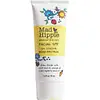What's inside
What's inside
 Key Ingredients
Key Ingredients

 Benefits
Benefits

 Concerns
Concerns

 Ingredients Side-by-side
Ingredients Side-by-side

Titanium Dioxide 5.3%
Cosmetic ColorantZinc Oxide 2.4%
Cosmetic ColorantCyclopentasiloxane
EmollientIsopropyl Myristate
EmollientPolyamide-5
Skin ConditioningDimethicone Crosspolymer
Emulsion StabilisingStearalkonium Hectorite
Gel FormingPolysilicone-11
Oryza Sativa Bran Extract
Skin ConditioningRosmarinus Officinalis Leaf Extract
AntimicrobialHelianthus Annuus Extract
EmollientTocopherol
AntioxidantMica
Cosmetic ColorantIron Oxides
Propylene Carbonate
SolventSynthetic Wax
AbrasiveHydrogen Dimethicone
Isopropyl Titanium Triisostearate
EmollientAluminum Hydroxide
EmollientSilica Silylate
EmollientOctyldodecyl Oleate
EmollientTitanium Dioxide 5.3%, Zinc Oxide 2.4%, Cyclopentasiloxane, Isopropyl Myristate, Polyamide-5, Dimethicone Crosspolymer, Stearalkonium Hectorite, Polysilicone-11, Oryza Sativa Bran Extract, Rosmarinus Officinalis Leaf Extract, Helianthus Annuus Extract, Tocopherol, Mica, Iron Oxides, Propylene Carbonate, Synthetic Wax, Hydrogen Dimethicone, Isopropyl Titanium Triisostearate, Aluminum Hydroxide, Silica Silylate, Octyldodecyl Oleate
Zinc Oxide 16%
Cosmetic ColorantAloe Barbadensis Leaf Juice
Skin ConditioningPersea Gratissima Fruit Butter
EmollientWater
Skin ConditioningCaprylic/Capric Triglyceride
MaskingCaprylyl Glycol
EmollientCetyl Alcohol
EmollientCitrus Sinensis Peel Oil Expressed
PerfumingDaucus Carota Sativa Seed Oil
EmollientEthylhexylglycerin
Skin ConditioningGlycerin
HumectantIsostearic Acid
CleansingJasminum Officinale Oil
MaskingPersea Gratissima Oil
Skin ConditioningPhenethyl Alcohol
MaskingPolyglyceryl-3 Beeswax
EmulsifyingPolyglyceryl-6 Distearate
EmulsifyingRubus Idaeus Seed Oil
EmollientSimmondsia Chinensis Seed Oil
EmollientSodium Ascorbyl Phosphate
AntioxidantSodium Hyaluronate
HumectantPPG-5 Tocopheryl Ether
AntioxidantZinc Oxide 16%, Aloe Barbadensis Leaf Juice, Persea Gratissima Fruit Butter, Water, Caprylic/Capric Triglyceride, Caprylyl Glycol, Cetyl Alcohol, Citrus Sinensis Peel Oil Expressed, Daucus Carota Sativa Seed Oil, Ethylhexylglycerin, Glycerin, Isostearic Acid, Jasminum Officinale Oil, Persea Gratissima Oil, Phenethyl Alcohol, Polyglyceryl-3 Beeswax, Polyglyceryl-6 Distearate, Rubus Idaeus Seed Oil, Simmondsia Chinensis Seed Oil, Sodium Ascorbyl Phosphate, Sodium Hyaluronate, PPG-5 Tocopheryl Ether
Ingredients Explained
These ingredients are found in both products.
Ingredients higher up in an ingredient list are typically present in a larger amount.
Zinc Oxide is a mineral broad-spectrum UV filter; it is the broadest UVA and UVB reflector approved by the FDA. It also has skin protectant and skin soothing properties.
Zinc oxide is one of the most effective broad-spectrum UV filters. It protects against UVB, UVAII, and UVAI. In comparison to its counterpart titanium dioxide, zinc oxide provides uniform and extended UVA protection.
Another great benefit? This ingredient is highly photostable so it won't degrade easily under sunlight.
A common myth is that mineral UV filters are widely believed to primarily reflect UV light.
However, modern research shows titanium dioxide absorbs UV radiation like chemical filters (~95% absorption & 5% reflection).
Zinc oxide has great skin soothing properties so you'll likely find this in sunscreens formulated for sensitive skin or babies/children. It is unlikely to cause "eye sting" like other sunscreen ingredients.
Regulatory agencies consider zinc oxide to be non-toxic and safe. It has also been shown to not penetrate the skin.
Unfortunately, this ingredient does leave a visible white cast. This is why mineral sunscreens are often less cosmetically elegant than chemical or hybrid ones.
In cosmetics, zinc oxide can be found in both non-nano and nano-sized forms. The nano version is used to reduce white cast and improve the texture of sunscreen formulas.
There are ongoing concerns surrounding nano-zinc oxide's impact on marine ecosystems and whether it can be absorbed into skin.
Regarding marine ecosystems and coral reefs, there is no conclusive evidence that any form of zinc oxide (or any other sunscreen ingredients) will cause harm. The science is still developing but many consumers are keeping a close eye on this issue.
Please note, many destinations have reef-safety sunscreen rules. For instance, the U.S. Virgin Islands advises all visitors to use non-nano mineral sunscreens.
There has also been some stir about whether micronized or nano zinc oxide has potential photoxicity and absorption through the skin/lungs.
An in-vitro (done in a test tube or petri dish) study demonstrated micronized zinc oxide to have potential phototoxicity. There's no need to fret; the EU Commission's Scientific Committee on Consumer Safety has stated, "The relevance of these findings needs to be clarified by appropriate investigations in vivo." Or in other words, further studies done on living organisms are needed to prove this.
Current research shows zinc oxide nanoparticles do not penetrate intact or sunburned skin. They either remain on the surface or in the outermost layer of dead skin (stratum corneum).
Zinc oxide is one of only two classified mineral UV filters with titanium dioxide being the other one.
Fun fact: Zinc has been used throughout history as an ingredient in paint and medicine. An Indian text from 500BC is believed to list zinc oxide as a salve for open wound. The Ancient Greek physician Dioscorides has also mentioned the use of zinc as an ointment in 1AD.
Learn more about Zinc Oxide